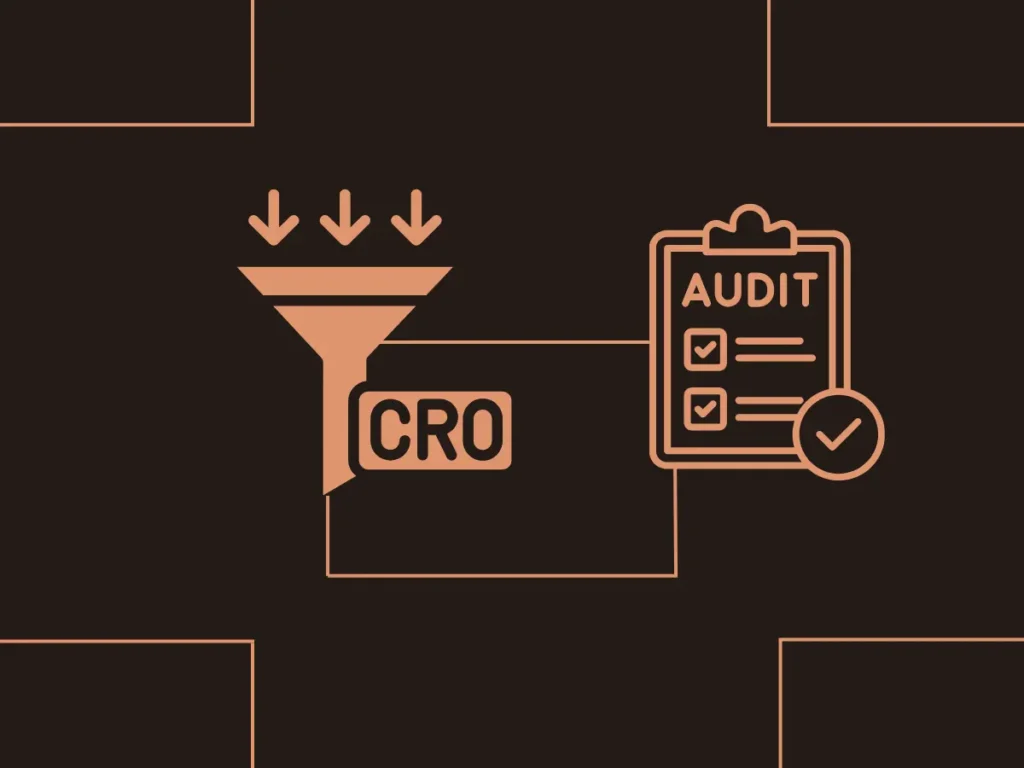
So, you’ve got a business website and you’re probably spending time and money driving people to it. But let me ask you this: are those visitors actually turning into customers? If not, that’s where a CRO Audit (Conversion Rate Optimization Audit) comes in.
Think of a CRO Audit like a health checkup for your website. It shows you what’s working, what isn’t, and how you can change things to turn more of those visitors into paying customers.
And here’s the thing, you’re not the only one facing this problem. A lot of business owners struggle with getting traffic but not seeing results. That’s exactly why a CRO Audit is so powerful. It gives you a clear picture of what’s going wrong and how to fix it, so your website finally starts doing what it’s meant to do: convert browsers into buyers.
If you’re curious about the common reasons websites fail to convert and practical steps you can take, we’ve broken it all down in this guide: Why Your Website Isn’t Converting (and How to Fix It).
What is a CRO Audit?
A CRO audit (Conversion Rate Optimization audit) is like putting your website under a microscope to see what’s working and what’s not. It’s a systematic review of your website’s conversion funnel, user experience, and overall performance to identify opportunities for improvement.
When you conduct a CRO audit, you’re essentially playing detective, looking for clues about why visitors aren’t taking the actions you want them to take. Whether that’s making a purchase, signing up for your newsletter, or filling out a contact form, every element of your site plays a role in conversion optimization.
Why Your Business Needs a CRO Audit
Let’s face it, getting people to visit your website isn’t free. Whether you’re running ads, investing in SEO, or putting time into content marketing, every single visitor costs you something. The real question is, are you making the most of those visitors once they land on your site?
That’s where a CRO audit comes in. A conversion rate optimization (CRO) audit digs into how your website is performing and shows you what’s stopping visitors from taking action, whether that’s making a purchase, signing up, or booking a call.

Imagine your site currently converts 2 out of every 100 visitors. If you optimize your site and raise that to just 3 out of 100, you’ve boosted your conversions by 50%. And the best part is that you did it without spending an extra dollar on traffic.
That’s the real power of a well-executed CRO audit, it helps you turn more of your existing traffic into actual customers. If you want to avoid common pitfalls that could be hurting your results, check out our full guide on website conversion rate mistakes to start optimizing smarter today.
Step-by-Step Guide to Conducting Your CRO Audit
Here is a step-by-step guide on how to do a CRO Audit for your business website:
1. Analyze Your Current Conversion Metrics
Start your CRO audit by gathering baseline data. Log into Google Analytics and examine your current conversion rates, bounce rates, and user behavior patterns. Look at metrics like:
- Overall conversion rate
- Page-specific conversion rates
- Traffic sources and their conversion performance
- User flow through your website
- Exit pages and bounce rates
This data forms the foundation of your conversion rate optimization strategy and helps you identify which areas need the most attention during your CRO audit.
2. Review Your Website’s User Experience
User experience is crucial for conversion optimization. During this phase of your CRO audit, put yourself in your visitors’ shoes. Navigate through your website and ask yourself:
- Is the navigation intuitive and easy to follow?
- Do pages load quickly across all devices?
- Is your website mobile-responsive?
- Are your call-to-action buttons prominently displayed?
- Is the checkout process (if applicable) streamlined?
Poor user experience is often the biggest culprit behind low conversion rates, making this a critical component of any CRO audit.
3. Examine Your Landing Pages
Your landing pages are where conversions happen, so they deserve special attention during your CRO audit. Evaluate each landing page for:

- Clear and compelling headlines
- Relevant and persuasive copy
- Strong call-to-action buttons
- Trust signals (testimonials, reviews, security badges)
- Minimal distractions
- Fast loading times
Since landing pages play such a big role in whether visitors convert or bounce, it’s worth diving deeper into how to optimize them effectively. This guide on Landing Page Optimization walks you through proven strategies to fine-tune your pages for better results.
Remember, conversion rate optimization is all about removing friction and making it as easy as possible for visitors to take action.
4. Test Your Forms and Checkout Process
Forms are conversion killers when they’re not optimized properly. Your CRO audit should include a thorough review of all forms on your website. Check for:
- Unnecessary form fields (keep only what’s essential)
- Clear error messages
- Logical field ordering
- Mobile-friendly design
- Progress indicators for multi-step forms
If you run an e-commerce site, pay special attention to your checkout process. Cart abandonment is a major issue that a good CRO audit can help address through conversion optimization techniques.
5. Analyze Your Content and Messaging
Content plays a huge role in conversion optimization. During your CRO audit, evaluate whether your messaging:
- Clearly communicates your value proposition
- Addresses common customer objections
- Uses persuasive language that resonates with your audience
- Includes social proof and testimonials
- Maintains consistency across all pages
Your CRO audit should reveal whether your content is helping or hindering conversions. And if you’d like to dive deeper into how to structure and optimize your website for better results, check out our full guide on optimizing your startup website.
Tools to Help With Your CRO Audit
You don’t need expensive tools to conduct an effective CRO audit, but some helpful options include:
- Google Analytics for conversion tracking and user behavior analysis
- Google Search Console for technical SEO issues that might affect conversions
- Hotjar or Crazy Egg for heatmaps and user session recordings
- Google PageSpeed Insights for website performance analysis
- Mobile-Friendly Test to ensure mobile optimization
These tools provide valuable insights that can guide your conversion rate optimization efforts and make your CRO audit more data-driven.
If you’d rather skip the trial-and-error and let experts handle it, our Conversion Rate Optimization Service at Techdella is here for you. We don’t just rely on tools; we combine them with proven strategies and smart execution to turn traffic into real revenue.
Partnering with a dedicated eCommerce CRO agency means you get more than just reports; you get results. Our team helps you uncover hidden opportunities, run data-driven experiments, and consistently boost your conversion rates, saving you time and resources while driving measurable growth.
Common Issues Uncovered During a CRO Audit
Through our experience with conversion optimization, here are the most frequent problems a CRO audit typically reveals:
- Weak Call-to-Action Buttons: Buttons that don’t stand out, use generic language, or aren’t strategically placed throughout the site.
- Slow Loading Times: Pages that take more than 3 seconds to load can significantly impact conversion rates.
- Lack of Trust Signals: Missing testimonials, reviews, security badges, or contact information that would build visitor confidence.
- Poor Mobile Experience: Websites that aren’t optimized for mobile users, who now represent the majority of web traffic.
- Confusing Navigation: Complex menu structures or unclear user pathways that make it difficult for visitors to find what they’re looking for.
Taking Action After Your CRO Audit
Once you’ve completed your CRO audit, it’s time to prioritize and implement improvements. Focus on changes that will have the biggest impact on conversion optimization:
- Start with quick wins: Fix obvious issues like broken forms or slow-loading pages
- Test major changes: Use A/B testing to validate significant modifications
- Monitor results: Track the impact of your changes on conversion rates
- Iterate continuously: Conversion rate optimization is an ongoing process, not a one-time fix
Remember, a CRO audit is just the beginning. The real value comes from acting on the insights you’ve gathered and continuously optimizing your website’s performance.
Frequently Asked Questions About CRO Audits
Conclusion
Conducting a CRO audit might seem daunting at first, but it’s one of the most valuable investments you can make in your business. By systematically reviewing your website’s conversion funnel and implementing data-driven improvements, you can significantly boost your conversion rates and maximize the value of every visitor.
Don’t let poor conversion optimization hold your business back. Start your CRO audit today and unlock the hidden potential in your existing website traffic. Your bottom line will thank you for it. If you’d like expert guidance, you can book a free discovery call with Techdella to explore how a tailored CRO strategy can work for your business.
Related Marketing Strategies

Ecommerce Sales Strategies to Increase Sales




